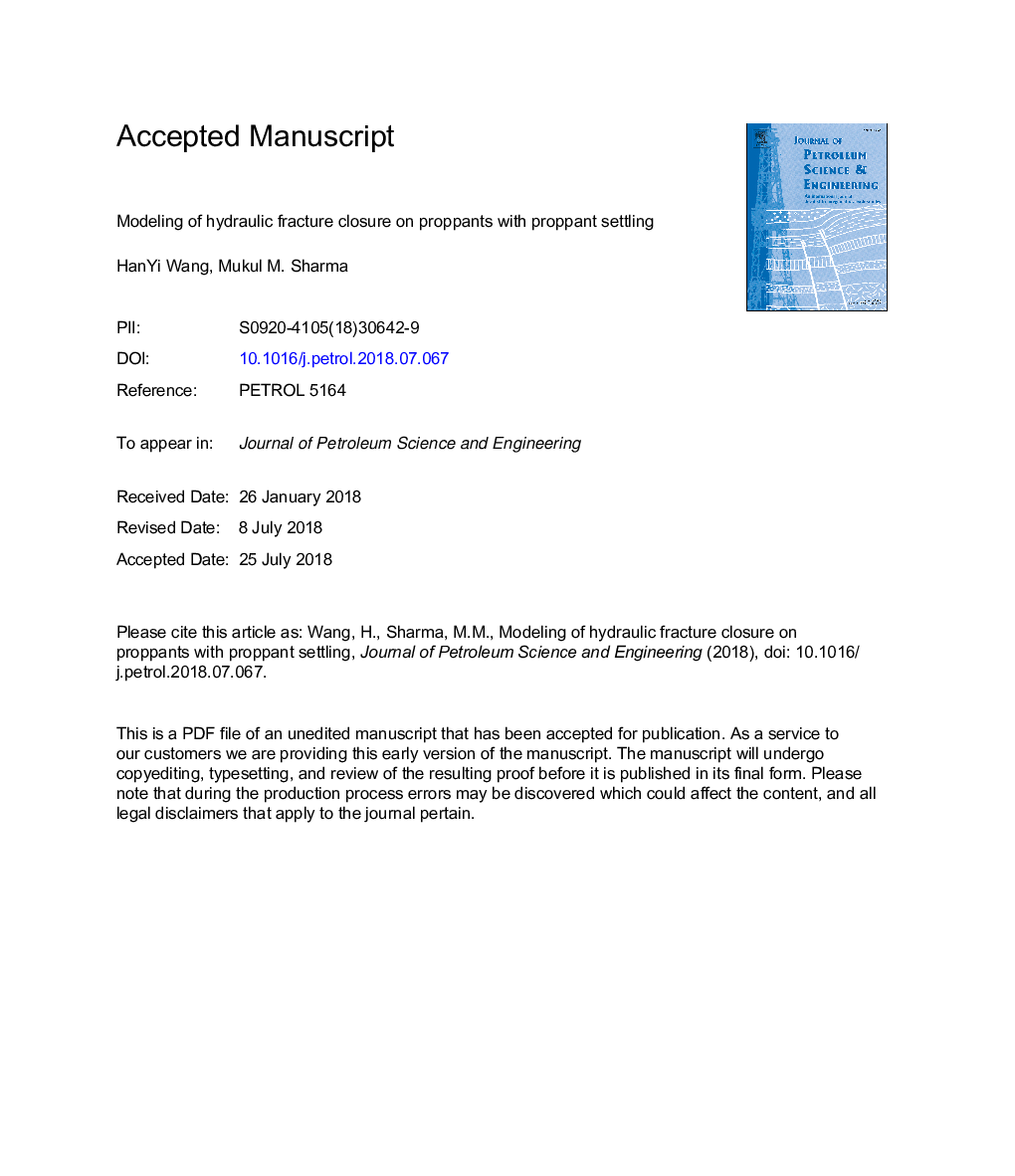| کد مقاله | کد نشریه | سال انتشار | مقاله انگلیسی | نسخه تمام متن |
|---|---|---|---|---|
| 8124344 | 1522770 | 2018 | 20 صفحه PDF | دانلود رایگان |
عنوان انگلیسی مقاله ISI
Modeling of hydraulic fracture closure on proppants with proppant settling
ترجمه فارسی عنوان
مدل سازی بستن شکست هیدرولیک بر روی پروپپانت ها با رسوب پروپاننت
دانلود مقاله + سفارش ترجمه
دانلود مقاله ISI انگلیسی
رایگان برای ایرانیان
کلمات کلیدی
شکستگی هیدرولیکی، بستن شکستگی، حمل و نقل پروپاننت، پله برقی تپاپانت تقویت استرس،
ترجمه چکیده
قرار دادن پروپپانت ها در یک شکست هیدرولیکی توسط جریان مایع، حمل و نقل پروپانتن و حل و فصل است. توزیع پروپانتن می تواند به طور قابل توجهی بر هدایت شکن هیدرولیکی تاثیر بگذارد و از این رو بر بهره وری چاه های شکسته هیدرولیکی تاثیر خواهد گذاشت. مطالعات گذشته، بسته شدن شکستگی روی پروپپانت ها را با درنظر گرفتن شکستگی های هیدرولیکی به عنوان دو ورقه موازی با پروپانتن های مساوی توزیع کرده اند. با این حال، در واقع، شکستگی های ناشی از هیدرولیکی در وسط و باریک تر در نزدیکی لبه های شکستگی گسترده تر هستند. علاوه بر این، به دلیل تخلیه پروپانتن، احتمالا در زیر شکسته شدن یک تپه پروپپتون قرار می گیرد. در نتیجه، بسته شدن شکستگی روی پروپپانت ها با هر دو هندسه شکست و توزیع پروپانتا در شکستگی کنترل می شود. این یک فرآیند پویا است که در آن هندسه شکست و بسته پروپاننت به عنوان یک تابع از فشار تکامل یافته است و مشکل تماس با سطح آن به علت ماهیت غیرخطی و غیرخطی آن به سختی حل می شود. در این مطالعه، یک رویکرد کلی به مدل بسته شدن شکستگی هیدرولیکی پیشنهاد شده است. پروفیل عرض شکستگی باقیمانده برای هر دو بخش تکیه شده و غیر متخلخل با فشارهای مختلف کششی برای سنگهایی با محیط رسی متفاوت، می تواند به دست آید. حداکثر استرس بر روی پروپپانت ها می تواند محاسبه شود تا انتخاب پروپانتان با قدرت مناسب را هدایت کند. مهمتر از همه، اگر یک آپارتمان پروپاننت یا بانک تشکیل شود، تأثیر تمرکز استرس و تقویت استرس می تواند تعیین شود. ما همچنین نشان می دهیم که روش سنتی برآورد حداکثر استرس بر روی یک بسته پروپپتون، کم توجهی است.
موضوعات مرتبط
مهندسی و علوم پایه
علوم زمین و سیارات
زمین شناسی اقتصادی
چکیده انگلیسی
The placement of proppants in a hydraulic fracture is governed by slurry flow, proppant transport and settlement. The proppant distribution can significantly affect the conductivity of the hydraulic fracture, and hence will impact the productivity of hydraulic fractured wells. Past studies have investigated fracture closure on proppants by envisioning hydraulic fractures as two parallel plates with uniformly distributed proppants. However, in reality, hydraulically induced fractures are wider in the middle and narrower near the fracture edges. In addition, a proppant dune is likely to be accumulated at the bottom of the fracture because of proppant settling. As a result, fracture closure on proppants is controlled by both fracture geometry and the distribution of proppant in the fracture. This is a dynamic process where fracture geometry and the proppant pack will evolve as a function of pressure, and the associated surface contact problem is notoriously challenging to solve because of its nonlinear and nonlocal nature. In this study, we proposed a general approach to model hydraulic fracture closure. The residual fracture width profile for both propped and un-propped sections can be obtained at different drawdown pressures for rocks with different clay content. The maximum stress acting on proppants can be calculated to guide the selection of proppants with appropriate strength. Most importantly, the effect of stress concentration and stress amplification can be quantified when a proppant dune or bank is formed. We also show that the traditional method of estimating the maximum stress on a proppant pack is an underestimation.
ناشر
Database: Elsevier - ScienceDirect (ساینس دایرکت)
Journal: Journal of Petroleum Science and Engineering - Volume 171, December 2018, Pages 636-645
Journal: Journal of Petroleum Science and Engineering - Volume 171, December 2018, Pages 636-645
نویسندگان
HanYi Wang, Mukul M. Sharma,
